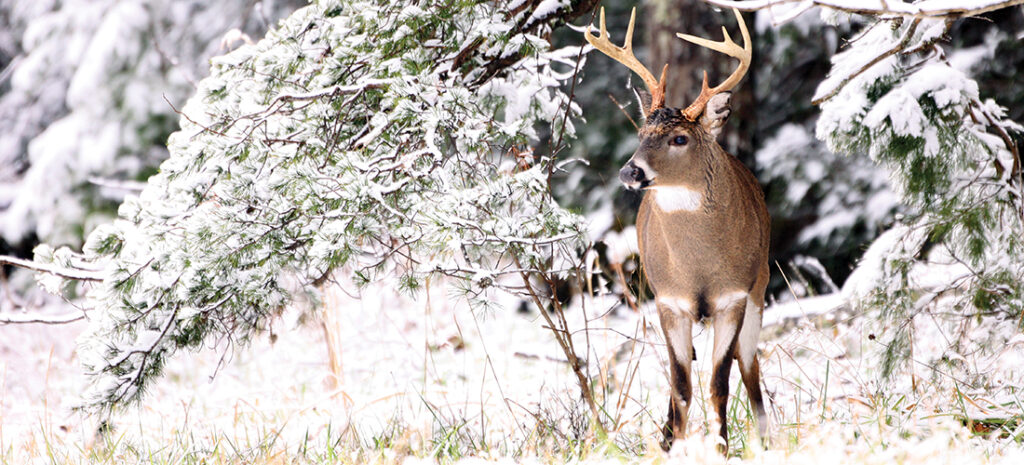Naturalist

Tale of the Whitetail
The adaptable deer among us
Story and Photographs by Todd Pusser
This past November, on a bright, sunny morning, I made a drive from Eagle Springs up to Raleigh. Just a quarter-mile into the journey, I spied a young doe lying motionless on her side, just off the shoulder of the road, a victim of a collision with an automobile from the previous night. “That’s a pity,” I said to myself, not giving it much more thought. Roadkill is an all-too-common sight these days.
Turning onto N.C. 211, I spotted another deer, this time a small buck, crumpled into a lifeless heap, its head lying just a few yards off the edge of the pavement, it too the victim of a car strike. A pair of black vultures stood nearby, cautiously eyeing a prospective meal.
Fifteen miles down the road, this time along U.S. 15-501 just north of Carthage, I spied yet another road-killed deer. Then another. Along U.S. 1, between Sanford and Cary, I counted four more. Later, driving back to Eagle Springs in the early evening, I counted another three, bringing the total to 11 dead deer for the day, all victims of hit and runs.
November is the peak of the white-tailed deer breeding season in this part of the state, and the large ungulates are on the move during most hours of the day, especially so once the sun goes down. Still, the volume of carnage seemed unusually high.
It was not that many years ago when seeing a white-tailed deer anywhere in the Sandhills was a rare treat. In fact, the only time I recall seeing any deer as a kid was when my parents made their annual holiday shopping trip to Cross Creek Mall in Fayetteville. Our route took us through the rural backroads of what is now Fort Liberty. From the back seat, I would strain my eyes looking up ahead, into the darkness, for the distinctive eyeshine of deer reflected in the high beams of our old Toyota Corolla. It was practically a given to find one or two standing along the shoulder of the road eating grass at some point during the drive, right in the heart of the military installation.
While deer were certainly around my hometown of Eagle Springs throughout the 1970s and ’80s, they were elusive and rarely seen by anyone other than hunters. Those roaming about the landscape tended to favor denser patches of forests bordering creeks and farm fields.
As a preteen, I recall being enthralled with the taxidermy mount of a large 8-point buck taken by a family friend during the fall hunting season along Drowning Creek, not far from our house, its large, symmetrical antlers appearing much too big for its head.
It was not until my college days of the early 1990s that I really began to notice a significant increase in the number of deer, not just in the Sandhills but throughout the state. During the occasional weekend drive from Chapel Hill to Eagle Springs for a home-cooked meal, I regularly saw deer dash across the road, day and night, especially along the edge of Jordan Lake.
Today, white-tailed deer are ubiquitous, roaming across North Carolina from the Outer Banks to our westernmost mountains, in numbers exceeding those seen by this country’s first European colonists.
Not long after my Raleigh outing, I ventured out under a bright moon, to drive the 4 miles of road bordering my childhood home. This stretch of asphalt traverses a series of large open fields, patches of longleaf pine forest, and the occasional manicured yard.
Rolling down the window to savor the unseasonably mild air, I set about the task of trying to accomplish my goal for the evening, which was to simply count the number of deer I could see in the 15 minutes it took to slowly drive the road. With no other cars out, I could easily stop and scan the fields and forests with my new thermal imaging scope. This high-tech piece of kit is able to detect the heat emitted by warm-blooded animals, allowing me to see in the dark.
Pulling up to my first stop, I raised the scope to my eye and turned it on. Instantly, I could see a large herd of deer grazing about 100 yards away, their distinctive bodies glowing like living Christmas tree lights scattered about the field. A quick count produced 18 deer. A quarter-mile down the road, I counted another eight. Then five more. By the time my informal survey was over, I had tallied a remarkable 53 deer, likely exceeding the total number of deer I had seen throughout the entirety of my childhood.
With the number of dead deer that litter our highways today, or that rummage through backyard gardens and local fairways, it might be hard to imagine that just a century ago, whitetails were wiped out of many areas of the East Coast (North Carolina included) by uncontrolled hunting. That they have bounced back in such a relatively short period of time is remarkable. The reasons for this are complicated and well beyond the scope of this short column. Suffice to say, white-tailed deer are among the few species that have readily adapted to a human-dominated landscape and are viewed by many as beacons of the American wilderness and by others as long-legged nuisances.
Pulling back into the driveway, I hop out of my car and start walking to the front door. A rustling of leaves in the turkey oaks bordering the yard catches my attention. Raising the thermal scope up to my eye, I see a doe bounding off into the forest in a series of high arching leaps, tail held high. PS
Naturalist and photographer Todd Pusser grew up in Eagle Springs. He works to document the extraordinary diversity of life both near and far. His images can be found at www.ToddPusser.com.
